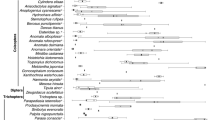Summary
-
1.
A pair of thermoreceptor units was identified in the sensilla coeloconica at the tip of the antennae on the mosquito,Aedes aegypti.
-
2.
One thermoreceptor was warm-sensitive and responded with a phasic-tonic increase in spike frequency to sudden increases in temperature. The second thermoreceptor was coldsensitive, responding with a phasic-tonic increase in spike activity to sudden decreases in temperature.
-
3.
The mean tonic spike activity of both the cold and warm receptors increased with increasing temperature to a peak of 30 imp/sec at 26‡ C for the cold receptor and 35 imp/sec at 28.5‡ C for the warm receptor. The tonic activity declined as the temperature was increased further. The maximum phasic sensitivity was observed with small temperature changes (δ T = ± 0.2‡C). This was 136 imp/sec/‡C temperature drop in the cold receptor and 130 imp/ sec/‡ C rise in the warm receptor.
-
4.
The importance of temperature in the host-seeking and “attack” behavior of the mosquito is discussed.
Similar content being viewed by others
References
Christophers, R.:Aedes aegypti, the yellow fever mosquito: Its life history, bionomics and structure. Cambridge: Cambridge Univ. Press 1960
Corbière-Tichané, G., Bermond, N.: Sensilles énigmatiques de l'antenne de certaine Coléoptères. Z. Zellforsch.127, 9–33 (1972)
Bernard, J., Pinet, J. M., Boistel, J.: électrophysiologie des récepteurs des stylets maxillaires deTriatoma infestans-Action de la temperature et de la teneur en eau de l'air. J. Insect Physiol.16, 2157–2180 (1970)
Daykin, P. N., Kellogg, F. E., Wright, R. H.: Host-finding and repulsion ofAedes aegypti. Can. Ent.97, 239–263 (1965)
Dethier, V. G., Arab, Y. M.: Effect of temperature on the contact chemoreceptors of the blowfly. J. Insect Physiol.2, 153–161 (1958)
Gillary, H. L.: Stimulation of the salt receptor of the blowfly. II. Temperature. J. gen. Physiol.50, 351–359 (1966)
Gillett, J. D.: Mosquitos. London: Weidenfeld and Nicolson (1971)
Hensel, H.: Thermoreceptors. Ann. Rev. Physiol.36, 233–249 (1974)
Hensel, H., Iggo, A.: Analysis of cutaneous warm and cold fibers in primates. Pflügers Arch.329, 1–8 (1971)
Hodgson, E. S.: Temperature sensitivity of primary chemoreceptors of insects. Anat. Rec.125, 560–561 (1956)
Holsapple, J. G., Florentine, G. J.: Thermal perception by the red flour beetle,Tribolium castaneum. Ann. ent. Soc. Amer.65, 388–390 (1972)
Howlett, F. M.: The influence of temperature upon the biting of mosquitos. Parasitology3, 479–484 (1910)
Ismail, I. A. H.: Comparative study of sense organs in the antennae of culicine and anopheline female mosquitos. Acta trop. (Basel)21, 155–168 (1964)
Lacher, V.: Elektrophysiologische Untersuchungen an einzelnen Rezeptoren für Geruch, Kohlendioxyd, Luftfeuchtigkeit und Temperatur auf den Antennen der Arbeitsbiene und der Drohne (Apis mellifica L.). Z. vergl. Physiol.49, 578–623 (1964)
Loftus, R.: The response of the antennal cold receptor ofPeriplaneta americana to rapid temperature changes and to steady temperature. Z. vergl. Physiol.59, 413–455 (1968)
McIver, S. B.: Fine structure of antennal sensilla coeloconica of culicine mosquitoes. Tissue and Cell5, 105–112 (1973)
Peterson, D. G., Brown, A. W. A.: Studies of the responses of femaleAedes mosquito. III. The response ofAedes aegypti (L.) to a warm body and its radiation. Bull. ent. Res.42, 535–541 (1951)
Roth, L. H.: Loci of sensory end-organs used by mosquitoesAedes aegypti (L.) andAnopheles quadramaculatus (Say) in receiving host stimuli. Ann. ent. Soc. Amer.44, 59–74 (1951)
Schoonhoven, L. M.: Some cold receptors in the larvae of three Lepidoptera sp. J. Insect Physiol.13, 821–826 (1967)
Steward, C. C., Atwood, C. E.: The sensory organs of the mosquito antenna. Canad. J. Zool.41, 577–594 (1963)
Uehara, S., Morita, H.: The effects of temperature on the labellar chemoreceptors of the blowfly. J. gen. Physiol.59, 213–266 (1972)
Waldow, U.: Elektrophysiologische Untersuchungen an Feuchte-, Trocken- und Kälterezeptoren auf den Antennen der WanderheuschreckeLocusta. Z. vergl. Physiol.69, 249–283 (1970)
Wigglesworth, V. B., Gillett, J. D.: The function of the antennae inRhodnius prolixus and the mechanism of orientation to the host. J. exp. Biol.11, 120–139 (1934)
Wright, R. H.: Tunes to which mosquitos dance. New Sci.37, 694–697 (1968)
Author information
Authors and Affiliations
Additional information
We thank Mr. Paul Houghton for his help in reducing the data and other technical assistance. This investigation was supported by NIH research grant number AI 10954.
Rights and permissions
About this article
Cite this article
Davis, E.E., Sokolove, P.G. Temperature responses of antennal receptors of the mosquito,Aedes aegypti . J. Comp. Physiol. 96, 223–236 (1975). https://doi.org/10.1007/BF00612696
Received:
Issue Date:
DOI: https://doi.org/10.1007/BF00612696




